X-ray Crystallography Reveals Parallel and Antiparallel β-Sheet Dimers of a β-Hairpin Derived from Aβ16-36 that Assemble to Form Different Tetramers
- PMID: 32584538
- PMCID: PMC7811405
- DOI: 10.1021/acschemneuro.0c00290
X-ray Crystallography Reveals Parallel and Antiparallel β-Sheet Dimers of a β-Hairpin Derived from Aβ16-36 that Assemble to Form Different Tetramers
Abstract
High-resolution structures of oligomers formed by the β-amyloid peptide, Aβ, are important for understanding the molecular basis of Alzheimer's disease. Dimers of Aβ are linked to the pathogenesis and progression of Alzheimer's disease, and tetramers of Aβ are neurotoxic. This paper reports the X-ray crystallographic structures of dimers and tetramers, as well as an octamer, formed by a peptide derived from the central and C-terminal regions of Aβ. In the crystal lattice, the peptide assembles to form two different dimers-an antiparallel β-sheet dimer and a parallel β-sheet dimer-that each further self-assemble to form two different tetramers-a sandwich-like tetramer and a twisted β-sheet tetramer. The structures of these dimers and tetramers derived from Aβ serve as potential models for dimers and tetramers of full-length Aβ that form in vitro and in Alzheimer's disease-afflicted brains.
Keywords: Alzheimer’s disease; Amyloid; Aβ; Crystal structure; Dimer; Oligomer; Tetramer.
Conflict of interest statement
The authors declare no competing financial interest.
Figures
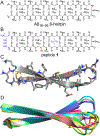
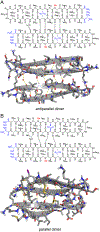
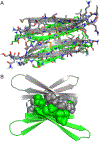
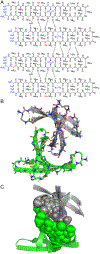
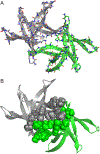


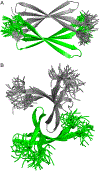
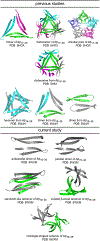
Similar articles
-
A Disulfide-Stabilized Aβ that Forms Dimers but Does Not Form Fibrils.Biochemistry. 2022 Feb 15;61(4):252-264. doi: 10.1021/acs.biochem.1c00739. Epub 2022 Jan 26. Biochemistry. 2022. PMID: 35080857 Free PMC article.
-
Elucidating the Structures of Amyloid Oligomers with Macrocyclic β-Hairpin Peptides: Insights into Alzheimer's Disease and Other Amyloid Diseases.Acc Chem Res. 2018 Mar 20;51(3):706-718. doi: 10.1021/acs.accounts.7b00554. Epub 2018 Mar 6. Acc Chem Res. 2018. PMID: 29508987 Free PMC article. Review.
-
A Hexamer of a Peptide Derived from Aβ16-36.Biochemistry. 2017 Nov 14;56(45):6061-6071. doi: 10.1021/acs.biochem.7b00831. Epub 2017 Oct 27. Biochemistry. 2017. PMID: 29028351 Free PMC article.
-
Polymorphism of oligomers of a peptide from β-amyloid.J Am Chem Soc. 2014 Apr 9;136(14):5432-42. doi: 10.1021/ja500996d. Epub 2014 Mar 26. J Am Chem Soc. 2014. PMID: 24669785 Free PMC article.
-
Oligomerizaiton and fibril asssembly of the amyloid-beta protein.Biochim Biophys Acta. 2000 Jul 26;1502(1):31-43. doi: 10.1016/s0925-4439(00)00030-2. Biochim Biophys Acta. 2000. PMID: 10899429 Review.
Cited by
-
A turn for the worse: Aβ β-hairpins in Alzheimer's disease.Bioorg Med Chem. 2024 May 1;105:117715. doi: 10.1016/j.bmc.2024.117715. Epub 2024 Apr 10. Bioorg Med Chem. 2024. PMID: 38615460 Free PMC article. Review.
-
β-Hairpin Alignment Alters Oligomer Formation in Aβ-Derived Peptides.Biochemistry. 2024 Jan 16;63(2):212-218. doi: 10.1021/acs.biochem.3c00526. Epub 2024 Jan 1. Biochemistry. 2024. PMID: 38163326 Free PMC article.
-
A Disulfide-Stabilized Aβ that Forms Dimers but Does Not Form Fibrils.Biochemistry. 2022 Feb 15;61(4):252-264. doi: 10.1021/acs.biochem.1c00739. Epub 2022 Jan 26. Biochemistry. 2022. PMID: 35080857 Free PMC article.
-
Synthesis and study of macrocyclic β-hairpin peptides for investigating amyloid oligomers.Methods Enzymol. 2021;656:123-168. doi: 10.1016/bs.mie.2021.04.023. Epub 2021 May 24. Methods Enzymol. 2021. PMID: 34325785 Free PMC article.
-
Computational Investigation of the Binding Dynamics of Oligo p-Phenylene Ethynylene Fluorescence Sensors and Aβ Oligomers.ACS Chem Neurosci. 2020 Nov 18;11(22):3761-3771. doi: 10.1021/acschemneuro.0c00360. Epub 2020 Nov 3. ACS Chem Neurosci. 2020. PMID: 33141569 Free PMC article.

